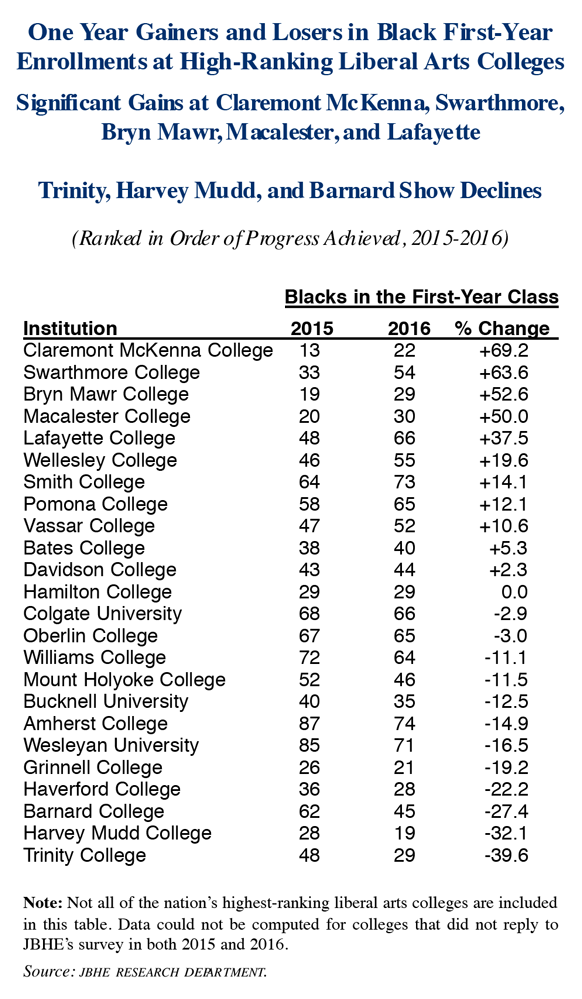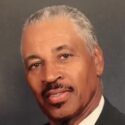![]() For the past 23 years JBHE has collected Black student admissions data from the highest-ranked liberal arts colleges. Over this long period, there have been 10 years when Amherst College in Massachusetts reported the highest percentage of Black first-year students. In fact, Amherst led the rankings for the eight of the past nine years. On six occasions, Wesleyan University in Middletown, Connecticut, had enrolled the highest percentage of Black first-year students. Williams College has also been a consistent performer in attracting a large group of Black first-year students and usually appears at or near the top of the rankings.
For the past 23 years JBHE has collected Black student admissions data from the highest-ranked liberal arts colleges. Over this long period, there have been 10 years when Amherst College in Massachusetts reported the highest percentage of Black first-year students. In fact, Amherst led the rankings for the eight of the past nine years. On six occasions, Wesleyan University in Middletown, Connecticut, had enrolled the highest percentage of Black first-year students. Williams College has also been a consistent performer in attracting a large group of Black first-year students and usually appears at or near the top of the rankings.
For the first time in the history of our survey, Pomona College in Claremont, California, has the highest percentage of Black students in this year’s entering classes at the nation’s leading liberal arts colleges. There are 65 Black first-year students at Pomona College this year. They make up 15.8 percent of the entering class. Pomona was second in our survey last year with an entering class that was 14.5 percent Black. Two years ago, Pomona also held the second position with an entering class that was 13.2 percent Black. Just three years ago, Blacks were only 8.8 percent of the first-year class at Pomona.

This year, Amherst College is a very close second in our survey. This breaks Amherst’s string of first places finishes in the last three JBHE surveys. There are 74 Black first-year students at Amherst this year, making up 15.7 percent of the entering class. Last year, there were 87 Black first-year students at Amherst. They made up a whopping 18.2 percent of the first-year class. This was largest percentage of Black first-year students at any of the high-ranking liberal arts colleges in the 23 years that JBHE has conducted this survey.
Swarthmore College in Pennsylvania ranks third in our survey. There are 54 Black first-year students at the college this year, making up 13 percent of the entering class. A year ago, Swarthmore ranked 14th in our survey of leading liberal arts colleges in the percentage of Black students in the entering class. Last year, Blacks were 8.1 percent of the first-year class.
As stated, Williams College has been a consistent performer and this year is no exception. There are 64 Black first-year students making up 11.6 percent of the entering class, placing Williams in fourth place in our survey. A year ago, Williams ranked third with an entering class that was 13.1 percent Black.
Smith College ranks fifth in our survey with an entering class that is 11.2 percent Black. A year ago, Smith ranked sixth with an entering class that was 10.4 percent Black. A big mover in our survey this year is Lafayette College in Easton, Pennsylvania. A year ago Lafayette ranked 17th with an entering class that was 7.1 percent Black. This year there are 66 Black first-year students who make up 10.2 percent of all entering students.
Oberlin College in Ohio, a liberal arts institution with a long history of providing educational opportunities for African Americans, ranked seventh in our survey. Wellesley College, a liberal arts educational institution for women in Massachusetts holds the eighth spot in our survey.
Wesleyan University, which as stated, has led our rankings on six occasions including three years ago, ranks ninth in this year’s survey. Blacks are 9.1 percent of the first-year class at Wesleyan. Four years ago when Wesleyan led the rankings, Blacks were 11.3 percent of the entering class.
Harvey Mudd College in Claremont, California, bills itself as the nation’s top liberal arts college of engineering, science and mathematics. It holds the tenth position in our survey with an entering class that is 8.8 percent Black. A year ago, Harvey Mudd College ranked fourth in our survey with an entering class that was 13 percent Black. In 2009, Harvey Mudd College ranked last in our survey in the Black percentage of first-year students. That year there were only three black students in the entering class. They made up just 1.4 percent of all entering students.
Here is one very encouraging statistic: In 2009, only three of the nation’s high-ranking liberal arts colleges had entering classes that were at least 10 percent Black. This year there are six. Another three major liberal arts colleges this year have entering classes that are at least 9 percent Black.
A Note on Methodology
Before we continue with the results, it is important to mention how the U.S. Department of Education collects data on the race of undergraduates. Before a change was made several years ago, students who reported more than one race (including African American) were included in the figures for Black students. This is no longer the case. Thus, students who self-identify as biracial or multiracial with some level of African heritage are no longer classified as Black by the Department of Education.
JBHE surveys have always asked respondents to include all students who self-identify as having African American or African heritage including those who are actually from Africa. JBHE has always maintained that biracial, multiracial, and Black students from Africa add to the diversity of a college campus. And including these students in our figures offers college-bound Black students a better idea of what they can expect at a given college or university. In order that we can compare our current data to past JBHE surveys we have continued to asked colleges and universities to include all students who identify themselves as having African American or African heritage.
Some of our responding liberal arts chose to report results that correspond with official Department of Education figures. They are indicated on the main table with an asterisk. It should be noted that if biracial, multiracial, and Black foreign students were included in the Black percentage of students in the first-year classes at these institutions, the overall percentage of Black students would undoubtedly be higher.
Liberal Arts Colleges: Short-Term Gainers

Now we turn to a comparison of this year’s results with the data from last year. For the 24 colleges for which we have data in both 2015 and 2016, 11 colleges posted gains over last year in Black enrollments. Twelve colleges showed a decline. Hamilton College has exactly the same number of Black students in its first-year class as it did a year ago. Last year, 18 liberal arts college reported an increase in the number of entering Black students from the previous year and only six posted declines.
Claremont McKenna College in California had the largest percentage increase in Black first-year students. There are 22 Black first year students at the college this year compared to 13 a year ago. The Black percentage of first year students increased from 3.8 percent in 2015 to 6.9 percent this year.
Swarthmore College and Bryn Mawr College in Pennsylvania, and Macalester College in St. Paul, Minnesota, all posted gains of at least 50 percent. At Macalester the increase resulted in an entering class that is 5.9 percent, compared to 3.4 percent a year ago, when Macalester ranked at the very bottom of our survey.
Lafayette College, Wellesley College, Smith College, Pomona College, and Vassar College in Poughkeepsie, New York all posted gains of at least 10 percent.
Leading liberal arts colleges that showed significant declines of at least 20 percent in Black first-year students were Trinity College in Hartford, Connecticut, Harvey Mudd College, Barnard College in New York City, and Haverford College in Pennsylvania.
Black Acceptance Rates at Liberal Arts Colleges
Acceptance rate data is a closely guarded secret at many high-ranking universities. But most of the nation’s leading liberal arts colleges are willing to disclose this information. This year, Amherst College and Wellesley College were the only high-ranking liberal arts colleges that declined to provide Black student acceptance rates.
Four years ago, for the first time in the history of the JBHE survey of liberal arts colleges, more responding colleges had a lower acceptance rate for Black students than their overall acceptance rate compared to the number of colleges that had a Black acceptance rate that was higher than their overall rate. This was true again in 2013, 2014, and 2015. This makes the fifth year in a row when more liberals arts college showed a lower acceptance rate for Black students than the acceptance rate for students overall. In fact, the trend has accelerated. This year, only five high-ranking liberal arts colleges had a Black student acceptance rate that was higher than for the overall applicant pool. Last year there were seven and two years ago there were nine. Many of these liberal arts colleges that had a high Black student acceptance rate were among the colleges that had the highest percentage of Blacks in their entering class.
While no firm conclusions can be made, the fact that for the past five years there are now more colleges with overall acceptance rates that are higher than Black acceptance rates, causes one to wonder if there has been some curtailment in colleges’ consideration of race in admissions decisions.
At the liberal arts colleges where the Black student acceptance rate was lower than the rate for all students, the differences were substantial at some institutions. For example, at Macalester College in Minnesota, 37.1 percent of all students were accepted but only 21.3 percent of Black students were admitted. At Mount Holyoke College, 52.2 percent of all applicants were accepted for admission but only 29.9 percent of Black applicants were accepted.
Student yield is calculated by seeing what percentage of accepted students decided to enroll. Among the leading liberal arts colleges who supplied this information to JBHE, the highest Black student yield was at Lafayette College. There, 55 percent of all accepted Black students decided to enroll. Pomona College and Davidson College in North Carolina were the only other leading liberal arts colleges that had a Black student yield of more than 40 percent.











The name of the JBHE journal should be “The Journal of African Americans in Higher Education. We do not use “RED” or “YELLOW” to describe other racial types anymore.
I argue only geography, religion, language and culture truly define the various groups that inhabit our planet.
And we know science tells us there is no such thing as race…Thus no black or white.
If one is from the continent of Africa or of African American descent, one is still categorized as Black in the eyes of a police officer or any other cause for racial profiling. Neglecting the fact that society still categorizes Black people as such only allows for policies against ALL Black people to go unnoticed, as many neoliberal policies have done.
It’s interesting to see that the college with the largest increase in the percentage of black first-years is Claremont McKenna, which made national news in fall 2015 for protests by POC about a lack of institutional support (http://tsl.news/news/5265). It seems they may be trying to correct their image.